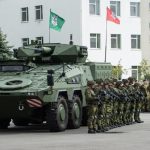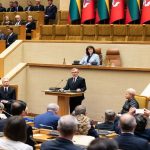BALTIC MONITOR
Date: 22 July 2019
Estonian War of Leaders: President Kaljulaid Versus Deputy Prime Minister Helme
The recent attacks of the liberal president on the national-conservative coalition party may lead to a political crisis in Estonia. Although it has been a few months, some Estonian politicians as well as large media platforms still have not come to terms with the fact that Eurosceptic EKRE forms the government. Now, they are using the liberal Western media to fight the right-wing party.

In the March parliamentary elections, the national-conservative, anti-immigrant and Eurosceptic Conservative People’s Party of Estonia (EKRE) obtained almost 18% of the vote, becoming the third force in the parliament. As a party that constantly causes controversy and is often accused of xenophobia and racism, it seemed that EKRE would be completely isolated in the opposition. However, surprisingly, the two largest parties, the liberal Reform Party and the centre-left Centre Party, did not get along with each other. Therefore, to the amazement of many, a three-party coalition between the Centre Party, right-wing EKRE and a small, conservative-liberal party known as Isamaa was formed. Thanks to this political arrangement, the leader of the Centre Party, Jüri Ratas has remained Prime Minister of Estonia. However, the Centrists’ decision met with widespread criticism from the media (including the Western media) as well as the oppositional Liberals (Reform Party) and the Social Democrats (SDE). As far as intensity is concerned, such a heated political conflict has not been seen in Estonia for many years. Moreover, the fact that President Kersti Kaljulaid took the side of the opposition has really added fuel to the fire.
At the end of April, during the swearing-in ceremony of the new government (including the ministers from EKRE), Kaljulaid appeared in the parliament building wearing … a sports sweatshirt with the slogan “Speech is free”. It was a political happening aimed at EKRE politicians who demanded that some journalists be removed from the public media. Even then, EKRE leader Mart Helme commented on the president’s behaviour calling it “an act of an emotionally heated woman”. During her speech in the parliament, Kaljulaid called for 100 “hate-free” days, clearly referring to EKRE. However, after 85 days, the president did an interview in which she herself says that she “hates” EKRE politicians.
Support Us
If content prepared by Warsaw Institute team is useful for you, please support our actions. Donations from private persons are necessary for the continuation of our mission.
The interview was for the American magazine “Foreign Policy”. The article was published under the controversial title “Estonia battles its elected racists”, and Kaljulaid says in it that she “hates” EKRE politicians for their behaviour. She, in fact, apologises to the Western public for Estonia’s co-ruling party. Mart Helme, who is the EKRE leader, First Deputy Prime Minister and Minister of the Interior, responded by calling on Kaljulaid to resign from office. According to Helme, if the president “declares to the whole world that she hates a party that received a strong mandate from voters, then there is probably something wrong with her nervous system”. There have also been allegations of abuse of power and even of violation of the Constitution. It is difficult to back up these claims since Kaljulaid expressed her opinion and it is impossible to prove that this was a direct attempt to influence Estonia’s internal affairs through foreign policy. The fact is, however, that this sort of Kaljulaid’s provocative behaviour implies that this is all about sparking off a crisis in the coalition government and putting pressure on Prime Minister Ratas. It is also possible that this is all about setting the stage for the second vote of no confidence for Helme.
As opposed to EKRE, Kersti Kaljulaid is in a much weaker position, because her electoral legitimacy is incomparably weaker than that of the co-governing party. For starters, in Estonia, the president is not elected via general election. This is usually done by Members of the Parliament. And in the case of Kaljulaid, it was an emergency choice aimed at preventing a crisis. In August 2016, the parliament voted three times to elect a new president but with no success. In September, the Electoral College (the MPs and the representatives of local governments) voted two times but once again failed to elect the president. Then, the election returned to the parliament. To end the impasse in choosing a candidate from one of the main parties, a compromise was finally reached. Kaljulaid, who had served as Estonia’s representative in the European Court of Auditors for several years, was appointed President of Estonia. She is often criticised for making rather bizarre and out-of-the-ordinary political decisions. For example, she decided to relocate the President’s Office to the city of Narva for some time, which was an obvious gesture towards the Russian-speaking minority. Kaljulaid’s recent visit to Russia, which was arbitrary and completely inconsistent with the government’s policy, was even a greater surprise which caused public outrage (the President of Estonia performs mainly representative functions). For Estonia, there was nothing to be gained from the meeting with Vladimir Putin, however, image-wise, the President of Russia took full advantage of the opportunity.
All texts published by the Warsaw Institute Foundation may be disseminated on the condition that their origin is credited. Images may not be used without permission.














